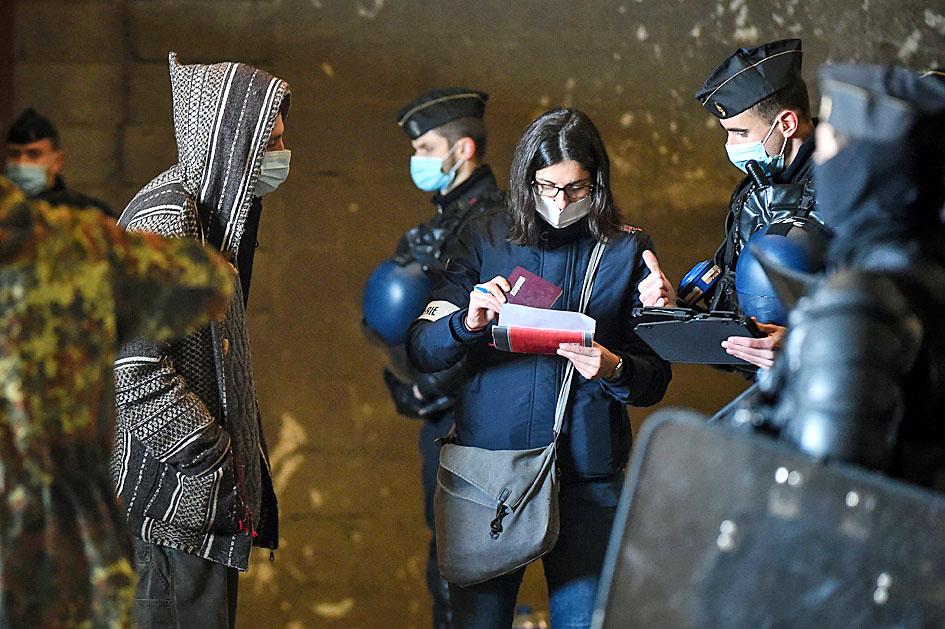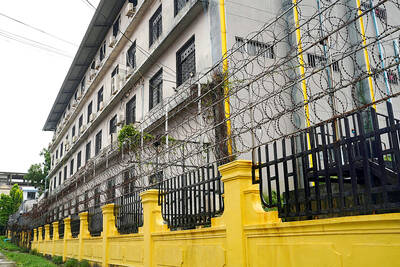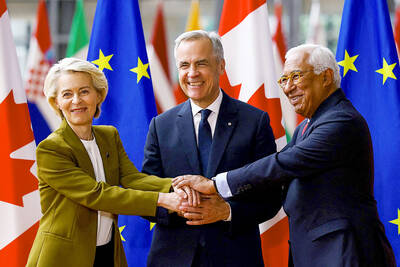Revelers early yesterday began leaving an illegal New Year rave in northwestern France that drew about 2,500 people, led to clashes with police and sparked concerns that it could spread COVID-19.
The local prefecture said in a statement that the music had been switched off after two nights and the first revellers began leaving the site before dawn.
“There has been no intervention by security forces,” it said in a statement, but added that police were checking all those leaving the site.

Photo: AFP
The revelers had set up the illegal rave in Lieuron, south of Rennes in Brittany, after skirmishes with police, the prefecture said in the statement.
Local gendarmes tried to “prevent this event, but faced fierce hostility from many partygoers,” who set one of their vehicles on fire and threw bottles and stones, the statement said.
Those present had come from across France and even abroad, it said.
By Friday evening, the sound of techno music could still be heard from the party venue, although police were preventing any newcomers from joining the rave, an Agence France-Presse photographer said.
“Police controls are taking place around the site. Verbal warnings are being given to everyone leaving,” the police said on social media.
Speaking later on BFM TV, French Ministry of the Interior spokeswoman Camille Chaize said there had been “great hostility, great violence” against the forces of law and order.
Such mass gatherings are strictly prohibited across France to prevent the spread of COVID-19, and a nationwide 8pm curfew — which was not lifted for New Year — applies across the country.
Reports said that the rave party took place in an empty warehouse belonging to a storage company.
Prosecutors have opened an investigation into the illegal organization of a musical gathering and premeditated violence against persons in authority.
Participants interviewed by reporters said that the revelers had included partygoers from foreign countries, including Spain and the UK.
One participant, who gave his name as Jo from the Alsace region of eastern France and refused to be identified further, said they had all met at a designated spot on Thursday evening in the parking lot of a shopping center.
A convoy then headed for Lieuron, where the police tried to prevent them from passing, he said.
He said that “very few had respected social distancing” at the event.

Drug lord Jose Adolfo Macias Villamar, alias “Fito,” was Ecuador’s most-wanted fugitive before his arrest on Wednesday, more than a year after he escaped prison from where he commanded the country’s leading criminal gang. The former taxi driver turned crime boss became the prime target of law enforcement early last year after escaping from a prison in the southwestern port of Guayaquil. Ecuadoran President Daniel Noboa’s government released “wanted” posters with images of his face and offered US$1 million for information leading to his capture. In a country plagued by crime, members of Fito’s gang, Los Choneros, have responded with violence, using car

CYBERCRIME, TRAFFICKING: A ‘pattern of state failures’ allowed the billion-dollar industry to flourish, including failures to investigate human rights abuses, it said Human rights group Amnesty International yesterday accused Cambodia’s government of “deliberately ignoring” abuses by cybercrime gangs that have trafficked people from across the world, including children, into slavery at brutal scam compounds. The London-based group said in a report that it had identified 53 scam centers and dozens more suspected sites across the country, including in the Southeast Asian nation’s capital, Phnom Penh. The prison-like compounds were ringed by high fences with razor wire, guarded by armed men and staffed by trafficking victims forced to defraud people across the globe, with those inside subjected to punishments including shocks from electric batons, confinement

The team behind the long-awaited Vera Rubin Observatory in Chile yesterday published their first images, revealing breathtaking views of star-forming regions as well as distant galaxies. More than two decades in the making, the giant US-funded telescope sits perched at the summit of Cerro Pachon in central Chile, where dark skies and dry air provide ideal conditions for observing the cosmos. One of the debut images is a composite of 678 exposures taken over just seven hours, capturing the Trifid Nebula and the Lagoon Nebula — both several thousand light-years from Earth — glowing in vivid pinks against orange-red backdrops. The new image

Canada and the EU on Monday signed a defense and security pact as the transatlantic partners seek to better confront Russia, with worries over Washington’s reliability under US President Donald Trump. The deal was announced after a summit in Brussels between Canadian Prime Minister Mark Carney and European Commission President Ursula von der Leyen and European Council President Antonio Costa. “While NATO remains the cornerstone of our collective defense, this partnership will allow us to strengthen our preparedness ... to invest more and to invest smarter,” Costa told a news conference. “It opens new opportunities for companies on both sides of the